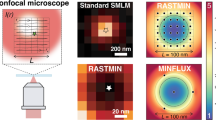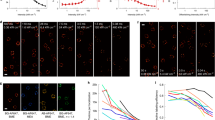Abstract
Remarkable progress in optical microscopy has been made in the measurement of nanometre distances. If diffraction blurs the image of a point object into an Airy disk with a root-mean-squared (r.m.s.) size of s = 0.44λ/2NA (∼90 nm for light with a wavelength of λ = 600 nm and an objective lens with a numerical aperture of NA = 1.49), limiting the resolution of the far-field microscope in use to d = 2.4s ≈ 200 nm, additional knowledge about the specimen can be used to great advantage. For example, if the source is known to be two spatially resolved fluorescent molecules, the distance between them is given by the separation of the centres of the two fluorescence images1. In high-resolution microwave and optical spectroscopy, there are numerous examples where the line centre is determined with a precision of less than 10−6 of the linewidth. In contrast, in biological applications the brightest single fluorescent emitters can be detected with a signal-to-noise ratio of ∼100, limiting the centroid localization precision to sloc ≥ 1% (≥1 nm) of the r.m.s. size, s, of the microscope point spread function (PSF)2. Moreover, the error in co-localizing two or more single emitters is notably worse, remaining greater than 5–10% (5–10 nm) of the PSF size3,4,5,6,7,8. Here we report a distance resolution of sreg = 0.50 nm (1σ) and an absolute accuracy of sdistance = 0.77 nm (1σ) in a measurement of the separation between differently coloured fluorescent molecules using conventional far-field fluorescence imaging in physiological buffer conditions. The statistical uncertainty in the mean for an ensemble of identical single-molecule samples is limited only by the total number of collected photons, to sloc ≈ 0.3 nm, which is ∼3 × 10−3 times the size of the optical PSF. Our method may also be used to improve the resolution of many subwavelength, far-field imaging methods such as those based on co-localization of molecules that are stochastically switched on in space6,7,8. The improved resolution will allow the structure of large, multisubunit biological complexes in biologically relevant environments to be deciphered at the single-molecule level.
This is a preview of subscription content, access via your institution
Access options
Subscribe to this journal
Receive 51 print issues and online access
$199.00 per year
only $3.90 per issue
Buy this article
- Purchase on Springer Link
- Instant access to full article PDF
Prices may be subject to local taxes which are calculated during checkout




Similar content being viewed by others
References
Bobroff, N. Position measurement with a resolution and noise-limited instrument. Rev. Sci. Instrum. 57, 1152–1157 (1986)
Yildiz, A. et al. Myosin V walks hand-over-hand: single fluorophore imaging with 1.5-nm localization. Science 300, 2061–2065 (2003)
Gordon, M. P., Ha, T. & Selvin, P. R. Single-molecule high-resolution imaging with photobleaching. Proc. Natl Acad. Sci. USA 101, 6462–6465 (2004)
Qu, X. et al. Nanometer-localized multiple single-molecule fluorescence microscopy. Proc. Natl Acad. Sci. USA 101, 11298–11303 (2004)
Ram, S., Ward, E. S. & Ober, R. J. Beyond Rayleigh’s criterion: a resolution measure with application to single-molecule microscopy. Proc. Natl Acad. Sci. USA 103, 4457–4462 (2006)
Betzig, E. et al. Imaging intracellular fluorescent proteins at nanometer resolution. Science 313, 1642–1645 (2006)
Rust, M. J., Bates, M. & Zhuang, X. Sub-diffraction-limit imaging by stochastic optical reconstruction microscopy (STORM). Nature Methods 3, 793–796 (2006)
Hess, S. T., Girirajan, T. P. K. & Mason, M. D. Ultra-high resolution imaging by fluorescence photoactivation localization microscopy. Biophys. J. 91, 4258–4272 (2006)
Burns, D. H. et al. Strategies for attaining superresolution using spectroscopic data as constraints. Appl. Opt. 24, 154–161 (1985)
Bornfleth, H. et al. High-precision distance measurements and volume-conserving segmentation of objects near and below the resolution limit in three-dimensional confocal fluorescence microscopy. J. Microsc. 189, 118–136 (1998)
Betzig, E. Proposed method for molecular optical imaging. Opt. Lett. 20, 237–239 (1995)
van Oijen, A. M. et al. Far-field fluorescence microscopy beyond the diffraction limit. J. Opt. Soc. Am. A 16, 909–915 (1999)
Lacoste, T. D. et al. Ultrahigh-resolution multicolor colocalization of single fluorescent probes. Proc. Natl Acad. Sci. USA 97, 9461–9466 (2000)
Antelman, J. et al. Nanometer distance measurements between multicolor quantum dots. Nano Lett. 9, 2199–2205 (2009)
Koyama-Honda, I. et al. Fluorescence imaging for monitoring the colocalization of two single molecules in living cells. Biophys. J. 88, 2126–2136 (2005)
Churchman, L. S. et al. Single molecule high-resolution colocalization of Cy3 and Cy5 attached to macromolecules measures intramolecular distances through time. Proc. Natl Acad. Sci. USA 102, 1419–1423 (2005)
Heilemann, M. et al. High-resolution colocalization of single dye molecules by fluorescence lifetime imaging microscopy. Anal. Chem. 74, 3511–3517 (2002)
Hell, S. W. & Wichmann, J. Breaking the diffraction resolution limit by stimulated emission: stimulated-emission-depletion fluorescence microscopy. Opt. Lett. 19, 780–782 (1994)
Klar, T. A. et al. Fluorescence microscopy with diffraction resolution barrier broken by stimulated emission. Proc. Natl Acad. Sci. USA 97, 8206–8210 (2000)
Rittweger, E. et al. STED microscopy reveals crystal colour centres with nanometric resolution. Nature Photon. 3, 144–147 (2009)
Lauer, T. R. The photometry of undersampled point-spread functions. Publ. Astron. Soc. Pacif. 111, 1434–1443 (1999)
Boggon, T. J. et al. C-cadherin ectodomain structure and implications for cell adhesion mechanisms. Science 296, 1308–1313 (2002)
Pertz, O. et al. A new crystal structure, Ca2+ dependence and mutational analysis reveal molecular details of E-cadherin homoassociation. EMBO J. 18, 1738–1747 (1999)
He, W., Cowin, P. & Stokes, D. L. Untangling desmosomal knots with electron tomography. Science 302, 109–113 (2003)
Chappuis-Flament, S. et al. Multiple cadherin extracellular repeats mediate homophilic binding and adhesion. J. Cell Biol. 154, 231–243 (2001)
Perret, E. et al. Trans-bonded pairs of E-cadherin exhibit a remarkable hierarchy of mechanical strengths. Proc. Natl Acad. Sci. USA 101, 16472–16477 (2004)
Zhang, Y. et al. Resolving cadherin interactions and binding cooperativity at the single-molecule level. Proc. Natl Acad. Sci. USA 106, 109–114 (2009)
Pokutta, S. et al. Conformational changes of the recombinant extracellular domain of E-cadherin upon calcium binding. Eur. J. Biochem. 223, 1019–1026 (1994)
Koch, A. W. et al. Calcium binding and homoassociation of E-cadherin domains. Biochemistry 36, 7697–7705 (1997)
Nagar, B. et al. Structural basis of calcium-induced E-cadherin rigidification and dimerization. Nature 380, 360–364 (1996)
Sivasankar, S. et al. Characterizing the initial encounter complex in cadherin adhesion. Structure 17, 1075–1081 (2009)
Kingshott, P., Thissen, H. & Griesser, H. J. Effects of cloud-point grafting, chain length, and density of PEG layers on competitive adsorption of ocular proteins. Biomaterials 23, 2043–2056 (2002)
Rasnik, I., McKinney, S. A. & Ha, T. Nonblinking and long-lasting single-molecule fluorescence imaging. Nature Methods 3, 891–893 (2006)
Vogelsang, J. et al. A reducing and oxidizing system minimizes photobleaching and blinking of fluorescent dyes. Angew. Chem. Int. Edn Engl. 47, 5465–5469 (2008)
Cheezum, M. K., Walker, W. F. & Guilford, W. H. Quantitative comparison of algorithms for tracking single fluorescent particles. Biophys. J. 81, 2378–2388 (2001)
Speidel, M., Jonáš, A. & Florin, E. Three-dimensional tracking of fluorescent nanoparticles with subnanometer precision by use of off-focus imaging. Opt. Lett. 28, 69–71 (2003)
Lang, M. J. et al. Simultaneous, coincident optical trapping and single-molecule fluorescence. Nature Methods 1, 133–139 (2004)
van Dijk, M. A. et al. Combining optical trapping and single-molecule fluorescence spectroscopy: enhanced photobleaching of fluorophores. J. Phys. Chem. B 108, 6479–6484 (2004)
Brau, R. R. et al. Interlaced optical force-fluorescence measurements for single molecule biophysics. Biophys. J. 91, 1069–1077 (2006)
Acknowledgements
A.P. wishes to thank S. R. Park for assistance with sample preparation and N. Gemelke, E. Sarajlic and H. Mueller for advice on electronics construction. Y.Z. is grateful to J. Nelson and A. Brunger for generously making laboratory facilities available. We thank A. Brunger for critical reading of the manuscript. This work was supported by the National Institutes of Health, the National Science Foundation, the National Aeronautics and Space Administration and the Defense Advanced Research Projects Agency.
Author information
Authors and Affiliations
Contributions
A.P. and S.C. conceived the idea. A.P. designed the experiments. A.P. developed and constructed the measurement apparatus. A.P. and Y.Z. wrote software to analyse the data. A.P. and Y.Z. prepared the reagents and samples. A.P. and Y.Z. developed the mapping function calibrations. A.P. performed the single-molecule measurements and data analysis. S.C. supervised the work and provided guidance. A.P. and S.C. wrote the manuscript.
Corresponding authors
Ethics declarations
Competing interests
The authors declare no competing financial interests.
Supplementary information
Supplementary Information
This file contains Supplementary Methods, a Supplementary Discussion, Supplementary Tables 1-3, References and Supplementary Figures 1-19 with legends. (PDF 833 kb)
Rights and permissions
About this article
Cite this article
Pertsinidis, A., Zhang, Y. & Chu, S. Subnanometre single-molecule localization, registration and distance measurements. Nature 466, 647–651 (2010). https://doi.org/10.1038/nature09163
Received:
Accepted:
Published:
Issue Date:
DOI: https://doi.org/10.1038/nature09163
This article is cited by
-
Tetra-color superresolution microscopy based on excitation spectral demixing
Light: Science & Applications (2023)
-
Enhancement of single upconversion nanoparticle imaging by topologically segregated core-shell structure with inward energy migration
Nature Communications (2022)
-
Direct-laser writing for subnanometer focusing and single-molecule imaging
Nature Communications (2022)
-
3D active stabilization for single-molecule imaging
Nature Protocols (2021)
-
Single-molecule localization microscopy
Nature Reviews Methods Primers (2021)
Comments
By submitting a comment you agree to abide by our Terms and Community Guidelines. If you find something abusive or that does not comply with our terms or guidelines please flag it as inappropriate.



